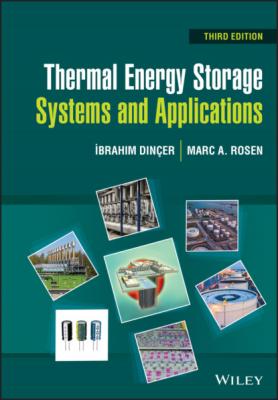Thermal Energy Storage Systems and Applications. Ibrahim Dincer
Читать онлайн.| Название | Thermal Energy Storage Systems and Applications |
|---|---|
| Автор произведения | Ibrahim Dincer |
| Жанр | Физика |
| Серия | |
| Издательство | Физика |
| Год выпуска | 0 |
| isbn | 9781119713142 |
(1.72)
while the flow velocity is
(1.73)
Figure 1.12 Uniform flow in a pipe.
Furthermore, the average velocity can be obtained by dividing the discharge by the flow area or depth as follows:
(1.74)
Uniform Flow in a Circular Tube
This case concerns uniform fluid flow in a pipe of radius R, as shown in Figure 1.12, which is the most common example in practical applications associated with pipe flows. Despite having the flow field as three‐dimensional, the assumption of radial symmetry makes the problem two‐dimensional. Therefore, the parabolic velocity distribution with the maximum velocity at the center of the pipe can be found as follows:
(1.75)
which is known as the Hagen–Poiseuille equation. The total volumetric flow rate can be calculated if the pressure gradient, along with other flow conditions, is specified and vice versa, as follows:
(1.76)
If the pipe is horizontally located (i.e. sin θ = 0), the above equations result in
(1.77)
(1.78)
1.5.4 Boundary Layer
If there is an equivalence between fluid and surface velocities at the interface between a fluid and a surface, it is called a “no‐slip” condition, which is entirely associated with viscous effects, as mentioned earlier. In practice, any real fluid flow shows a region of retarded flow near a boundary in which the velocity relative to the boundary varies from zero at the boundary to a value that may be estimated by the potential‐flow solution some distance away. This region of retarded flow is known as the boundary layer, which was first introduced by Prandtl in 1904. His hypothesis of a boundary layer was arrived at by experimental observations of the flow past solid surfaces.
Figure 1.13 Development of boundary layer in a viscous flow along a plate.
Of course, the boundary layer can be taken as the region of the fluid that is close to the surface immersed in the flowing fluid, and the boundary layer development takes place in both internal and external flows. In internal flows, it occurs until the entire fluid is encompassed, as in pipe flow and open‐channel flow. Boundary layer development is important for external flows, which exhibit a continued growth due to the absence of a confining boundary, such as a flow along a flat plate. It is, therefore, important to assume that the velocity at some distance from the boundary is unaffected by the presence of the boundary, referring to the free‐stream velocity us.
We now consider a uniform flow of incompressible fluid at a free‐stream velocity approaching the plate, as shown in Figure 1.13. Since the plate is stationary with respect to the earth, when the fluid is in contact with the plate surface, it has zero velocity (i.e. the “no‐slip” condition). Later, the boundary layer thickens in the direction of flow, and a velocity gradient at a distance δ over an increasingly greater distance normal to the plate takes place between the fluid in the free stream and the plate surface. The rate of change of velocity determines the velocity gradient at the surface as well as the shear stresses. The shear stress for the laminar boundary layer becomes
(1.79)
which varies with distance along the plate by the change in velocity. Further along the plate, the shear force is gradually increased, as the laminar boundary layer thickens, because of the increasing plate surface area affected, and the fluid becomes retarded, so that a turbulent boundary layer occurs as instabilities set in. Thus, the shear stress for the turbulent flow can be approximated as
(1.80)
Experimental studies indicate that there are two boundary layer flow regimes; a laminar flow regime and a turbulent flow regime, which can be characterized by the Reynolds number, as pointed out earlier. The transition from a laminar to a turbulent boundary layer is dependent mainly upon the following:
Re = usxc/v;
the roughness of the plate; and
the turbulence level in the free stream.
There are various boundary‐layer parameters to be considered, such as boundary‐layer thickness, the local wall shear stress (or local friction or drag coefficient), and the average wall shear stress (or average friction or drag coefficient). The boundary‐layer thickness may be expressed in several ways. The simplest approach is that the velocity u within the boundary layer approaches the free‐stream velocity us. From experimental measurements, it was observed that the boundary‐layer thickness δ can be defined as the distance from the boundary to the point at which u = 0.99us.
Table 1.6 gives the values of the boundary‐layer thicknesses for laminar flow along a flat plate as a function of dimensionless coordinates η = y(us/vx). These values are of practical interest in momentum analysis of fluid flow.
The momentum equations for velocity profiles can be summarized with respect to the momentum thickness, the average skin‐drag coefficient, and the displacement thickness (see Table 1.7 for a flat plate). As can be pointed out from the table, the laminar boundary‐layer thickness increases with x1/2 from the leading edge and inversely with
